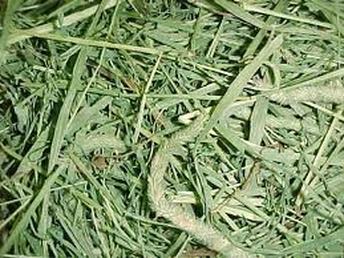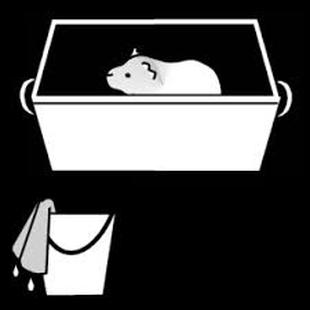How to Care for Guinea Pigs

Get large enough cages.
You should allow 7.5 square feet of cage space as a minimum for one guinea pig (even that is rather small), or 10.5 for two. However, the bigger the cage the better. A hutch outside is NOT recommended as guinea pigs have a very limited temperature tolerance. Other animals could break into the cage and harm them, as well. Your guinea pig(s) will be better off if they are housed inside, where they will be safe and warm,and where they can smell you, and also so that you can interact with them more.

Find a good location for the cage.
A place where the family frequents several times a day for decent periods of time is the best location. A living room, bedroom, or hallway is the best choice because there is frequent traffic. Your guinea pig will feel more included in your life and you'll be able to easily interact with your guinea pig whenever you pass by the cage. Just don't put the cage outside where there are lots of predators out there or in the garage car because the fumes can harm or even kill them and it can get very hot in the summer.
Interact and bond with your guinea pig several times daily.
Guinea pigs are an inherently social species and live in herds/groups in the wild. Frequent handling each day is essential to your guinea pig's happiness. Talk to your guinea pig, cuddle it, carry it, and pet it as often as you can and set aside plenty of time to play with your guinea pig.

Guinea pigs will also need some floor time each day — let them loose in an enclosed space.
You can do so by setting up a pen in a room (an area with easily-cleaned floors) or outside if it isn't too hot or cold . Make sure to have plenty of space in their exercise area so that they can run and play. This exercise time is crucial to a guinea pig's happiness. Make sure to put a few toys and tunnels in the play area.

Adopt two or more guinea pigs of the same gender or spayed/neutered so they are not lonely.
Guinea pigs need company because they are herd animals. Spend some time with your pets every day. There is no excuse for keeping a sociable animal alone. It will definitely be lonely, even if you spend as much time with it as you can. Individual enclosure equals animal abuse.

Make sure that fresh water is available to guinea pigs at all times.
- Change your guinea pigs' water bottle, clean and change it daily. Get a guinea pig/rabbit bottle with the little ball in the spout and keep it full.
- Be sure to clean the nozzle frequently to keep it free of hay and pellet gunk which can breed harmful bacteria and clog the water flow.
- Nozzle can be cleaned with a Q-tip.
- The water bottle itself can be cleaned by putting in uncooked rice and a little water, and shaking. The rice will dislodge any greenish build-ups (algae).
- If the cage is in the sun for part of the day, this can contribute to algae build-ups. In this case, cover the bottles with an opaque cloth to avoid algae.
- Avoid adding anything to the water such as vitamin tablets as they become ineffective very quickly and as they do not have a good taste, guinea pigs are unlikely to drink the water anyway.

Make grass hay such as timothy or orchard grass hay available to your pigs 24/7. Guinea pigs are grazing animals so they need something to graze on or their digestive tracts can shut down.
- Alfalfa hay should only be fed to babies 6 months old and younger, and pregnant or nursing sows, because they have a lot of extra nutrients that healthy adult guinea pigs do not require.
- Timothy, orchard grass, or bluegrass hay should be fed for guinea pigs older than 6 months. It should be fed 'free choice,' which means they have some in the cage all the time.
- Lack of hay can lead to malocclusion, a misalignment of the teeth that may require surgical correction, shutting down of the digestive tract often leading to death.

Make sure the guinea pigs get fresh vegetables daily.
Green leafy vegetables should make up about 20% of your guinea pigs' diet. Be careful about leafy vegetables as too many of these can cause stomach upsets and diarrhea.
Guinea Pig servings should include plenty of vegetables high in vitamin C (as guinea pigs are unable to produce their own vit. C - too little vit. C can lead to illnesses).
- Veggies good for guinea pigs include celery, carrots, off-the-vine tomatoes, cucumber, corn, small amounts of spinach and pod-peas. If a guinea pig seems unwilling to eat any vegetables, try cutting them up into slices or small chunks. Some fruits are ok for guinea pig treats such as strawberries and apple pieces but these can only be given occasionally as some of the acids can be harmful to guinea pigs.
- Vegetables to avoid include any vegetable in the cabbage family, iceberg lettuce, rocket salads, red leaves, broccoli, cauliflower, beet greens, potatoes, and radishes.
- Each guinea pig will require about one serving of one cup per day. Dividing the veggie meal into two servings is a good idea since guinea pigs are grazing animals who prefer to eat throughout the day instead of one big meal.
- Do not feed rabbit or other small animal pellets - the vitamin content is not the same, and can be harmful to your guinea pig!
- Feed a plain pellet, as pellets with seeds in them could cause choking. Pellets, hay, untreated fresh organic grass (wheat or standard lawn grass) and fresh veggies are all the foods guinea pigs need.

Supply your guinea pig with plenty of toys and cage accessories.
You can make your own toys out of boxes, paper bags, oatmeal containers, folders, and more. Be creative and use materials you find around the house.

Spot clean your guinea pigs' cage.
Try to do it daily, but at least once every two days, removing droppings and any uneaten veggies from the day before, cleaning the water bottle, and adding more hay to the cage.
Clean the cage thoroughly at least once a week.
The frequency of thorough cleaning depends on the type of bedding used and the number of guinea pigs you have.
Try to do it daily, but at least once every two days, removing droppings and any uneaten veggies from the day before, cleaning the water bottle, and adding more hay to the cage.
Clean the cage thoroughly at least once a week.
The frequency of thorough cleaning depends on the type of bedding used and the number of guinea pigs you have.
- Remove all debris, liners, bedding, food and toys and dispose of them or clean with a guinea pig friendly antibacterial spray. Don't use cleaning products designed for humans.
- Wipe down the inside of the cage/hutch with guinea pig friendly antibacterial spray. It is a good idea to let the cage/hutch air for a short while.
- Now replace the bedding. It is often useful to put a layer of newspaper under your other bedding to prevent urine stains. Newspaper should not be used for bedding on its own and should not be easily accessed by guinea pigs as they may ingest the ink.
- You can use CareFresh, moisture wicking fleece over towels, or aspen bedding.
- Do not use wood chips or sawdust as bedding.
- Make sure you provide an area for your guinea pig to sleep in - you can buy igloos from most pet stores or alternatively, you can provide loose hay for them to burrow in.

Trim toenails every few weeks.
If they have dark toenails, shine a flashlight behind the nail so you can see where the quicks. If you clip too close to the vessel the toe nail may start to bleed. Use syptic powder or flour to stop bleeding.

Wash your guinea pig every 3-4 months.
Do not wash any more frequently than this as it can make guinea pigs fur greasy which isn't good for their sensitive skin.
